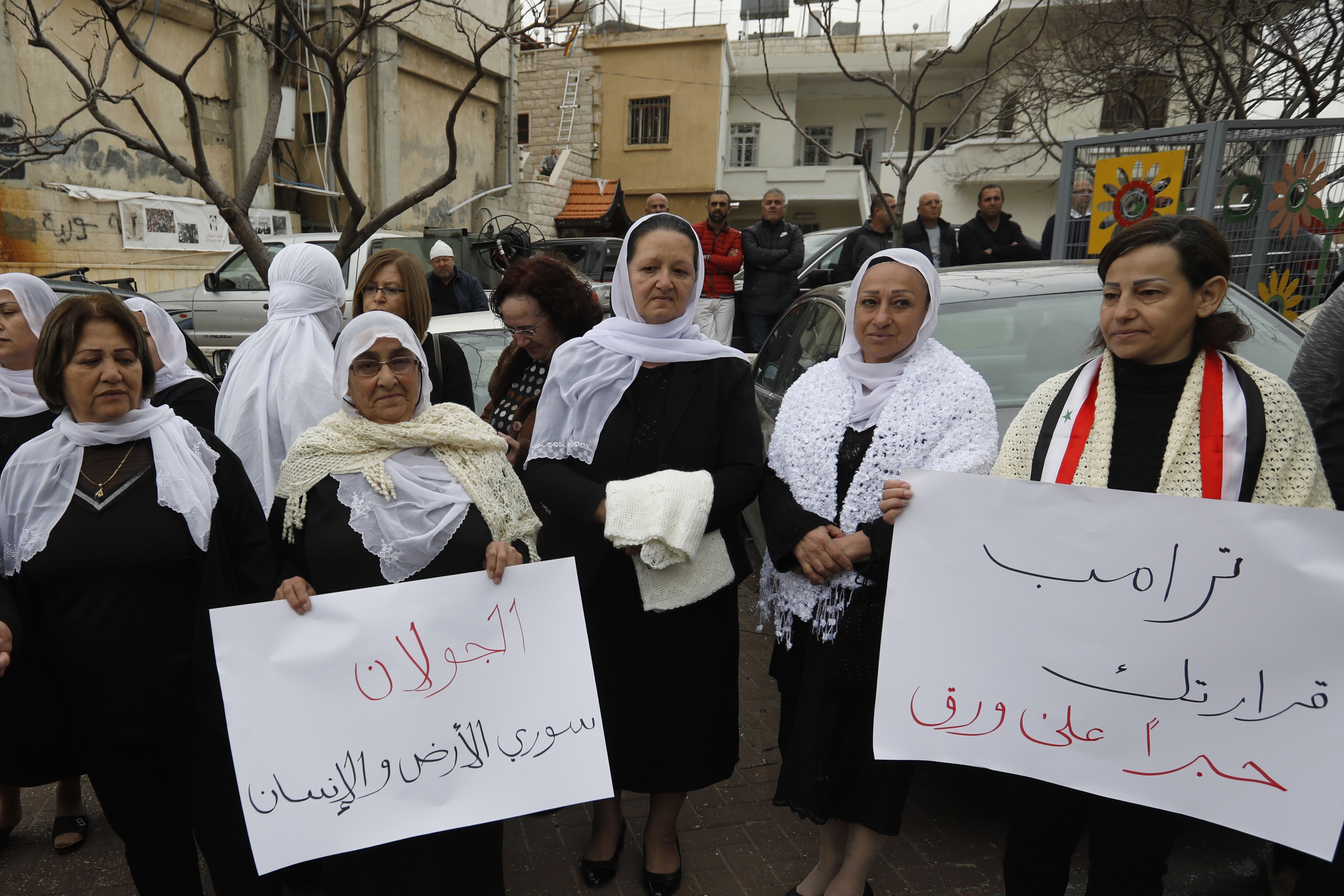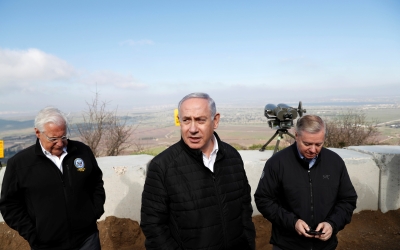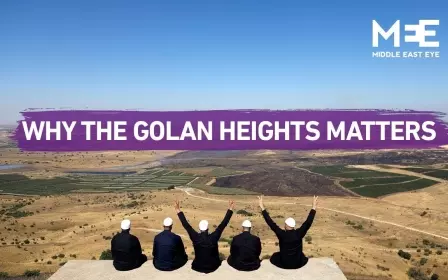Trump's Golan Heights decision: Endorsing illegal annexation

"After 52 years it is time for the United States to fully recognize Israel’s sovereignty over the Golan Heights, which is of critical strategic and security importance to the State of Israel and Regional Stability!"
Those were the words of US President Donald Trump in a tweet on 21 March 2019. Most likely, they will become official US policy when Trump meets Israeli Prime Minister on his visit to Washington to address the annual policy conference of AIPAC, the American Israel lobby on 26 March.
A gift to Netanyahu
A fortnight later on 9 April, there is a general election in Israel. Netanyahu is in the fight of his life to retain his premiership. He is being challenged by a new entrant into Israeli politics, the former head of the Israeli military Benny Gantz.
The timing of Trump's announcement is a political gift to Netanyahu. On the same day the prime minister received a political gift from US Secretary of State Mike Pompeo, who visited the Western Wall in Israeli-occupied East Jerusalem with him.
New MEE newsletter: Jerusalem Dispatch
Sign up to get the latest insights and analysis on Israel-Palestine, alongside Turkey Unpacked and other MEE newsletters
Instead of the US taking steps to persuade Israel to return the Golan Heights to Syria, the US is now proposing that Israel be rewarded for its aggression
By so doing, Pompeo tacitly recognised Israeli sovereignty over East Jerusalem (see below).
The US could be reasonably accused of interference in the Israeli general election.
US recognition of Israeli sovereignty over the Golan Heights was foreshadowed during the Trump presidential campaign by his advisory team on Israel - a team consisting of Jason Greenblatt, who is now Trump’s chief negotiator on Israel-Palestine (along with his son-in-law, Jared Kushner), and David Friedman, who is now US ambassador to Israel.
A joint statement by Greenblatt and Friedman on 2 November 2016 contained the following short but very significant sentence: "The false notion that Israel is an occupier should be rejected."
If that principle is implemented in full, the Trump administration will recognise all of the West Bank as Israeli sovereign territory, as well as the Golan Heights. It is not inconceivable.
Israel's record of violations
Israel took over the Syrian Golan Heights by force in June 1967 and around 100,000 Syrians were driven out or fled in the process. This Syrian territory has been under Israeli military occupation ever since.
In 1981, Israel annexed the territory. On 17 December 1981, the Security Council passed resolution 497 demanding that Israel reverse its annexation. The resolution declared that:
“The Israeli decision to impose its laws, jurisdiction and administration in the occupied Syrian Golan Heights is null and void and without international legal effect” and demanded that “Israel, the occupying power, should rescind forthwith its decision”.
The Golan Heights: Why it matters
+ Show - HideOfficially part of Syria since the country’s independence in 1944, the Golan Heights is a strategic plateau straddling Israel and Syria and overlooking southern Lebanon.
It was captured by Israel during the Middle East war of 1967 and subsequently annexed in a move never recognised by the international community.
The Golan is recognised as part of Syria by the United Nations. UN Resolution 242 calls for Israel to withdraw from the Golan and other occupied territories including the Gaza Strip and the West Bank.
However, Israel has repeatedly refused to do so and in 1981, it formally annexed the Syrian territory.
A UN peacekeeping force has patrolled the demarcation line between Syrian and Israeli-controlled areas of the Golan since 1974.
Israel has constructed settlements that are illegal under international law in the occupied territory and settled its citizens there.
Some 20,000 Israeli settlers currently live in the Golan, alongside around 26,000 of the territory’s native inhabitants, who are predominantly Druze and identify as Syrian.
Since the Syrian war erupted in 2011, Syrians in the Golan taking Israeli citizenship has become more common, though the vast majority reject it.
The Golan is thought to provide around one-third of Israel's fresh water supply. Water from the territory flows into the Sea of Galilee and Jordan River.
Other than its strategic significance - the Golan is the only land border between Israel and Syria - the territory is also used by Israelis for leisure purposes. The area counts an Israeli ski resort and several vineyards.
Israel refused to do so and it remains in violation of resolution 497 to this day.
The US voted for resolution 497, which was passed unanimously. In other words, it was US policy in December 1981 and until recently that the Golan Heights were Syrian territory, that Israel didn’t have sovereignty over them. Trump is now proposing to reverse that. To do so is in clear breach of Security Council resolution 497.
It is also in breach of Security Council resolution 2254 on Syria passed on 18 December 2015, in which the Security Council “reaffirm[ed] its strong commitment to the sovereignty, independence, unity and territorial integrity of the Syrian Arab Republic, and to the purposes and principles of the Charter of the United Nations”.
In December 1981, the Security Council declared that the Golan Heights were Syrian territory, and it hadn’t altered that opinion by December 2015, so when resolution 2254 speaks of the “territorial integrity of the Syrian Arab Republic” that includes the Golan Heights.
An act of aggression
The Rome Statute of the International Criminal Court now defines the crime of aggression and specifies the following as an "act of aggression":
"The invasion or attack by the armed forces of a State of the territory of another State, or any military occupation, however temporary, resulting from such invasion or attack, or any annexation by the use of force of the territory of another State or part thereof."
This colonisation of occupied territory has involved the commission of war crimes by Israel on a grand scale
There is no doubt that Israel’s military occupation of the Golan Heights for the past 52 years constitutes an act of aggression against the Syrian state.
Instead of the US taking steps to persuade Israel to cease this aggression and return the Golan Heights to Syria – which it could easily do by threatening to curtail military aid to Israel – the US is now proposing that Israel be rewarded for its aggression by keeping the territory it has seized permanently.
Israel has established more than 30 Jewish-only settlements in the Golan Heights with an estimated 20,000 settlers. This colonisation of occupied territory has involved the commission of war crimes by Israel on a grand scale.
Article 8.2(b)(viii) of the Rome Statute defines “the transfer, directly or indirectly, by the Occupying Power of parts of its own civilian population into the territory it occupies” to be a war crime.
In other words, when a state, which is occupying territory not its own, transfers some of its own civilians into that territory that process constitutes a war crime under international law.
There is little doubt that Israel’s colonisation programme in the Golan Heights (and in the West Bank, including East Jerusalem) has involved the commission by Israel of a tsunami of war crimes as defined in the Rome Statute.
Israel 'not an occupier'
It is clear that the principle set out by Greenblatt and Friedman in November 2016 that “the false notion that Israel is an occupier should be rejected” is being steadily implemented by the Trump administration.
For example, it has now been reflected in US State Department documents, which no longer refer to the West Bank (including East Jerusalem), Gaza and the Golan Heights as “occupied".
Earlier country reports on human rights practices for Israel/Palestine were titled Israel and the Occupied Territories (see, for instance, the 2016 report), the 2017 report, published on 20 April 2018, is titled "Israel, Golan Heights, West Bank and Gaza", though the Golan Heights are still described as "Israeli-occupied" in the text. The latter has been amended to “Israeli-controlled” in the 2018 report published on 13 March 2019.
On 16 November last year, there was an indication that the Trump administration was about to cease regarding the Golan Heights as "occupied" by Israel - at a UN General Assembly committee, the US opposed a resolution condemning Israel’s occupation of the Golan Heights for the first time, having abstained in previous years.
Despite the US opposition, the committee went on to approve a draft resolution by 151 votes to 2 with 14 abstentions. Only Israel joined the US in voting no. It wasn’t a complete surprise, therefore, when on 21 March 2019 Trump rejected the notion that Israel is an occupier in the Golan Heights.
On the same day, as I mentioned above, accompanied by the Israeli prime minister and the US Ambassador to Israel David Friedman, the US Secretary of State Mike Pompeo visited the Western Wall in Israeli-occupied East Jerusalem.
According to Israeli press reports: "His is the first-ever visit of a top US diplomat to the Western Wall with an accompaniment of an Israeli official". By entering East Jerusalem with the Israeli prime minister at his side, the US secretary of state tacitly recognised Israeli sovereignty over East Jerusalem.
By contrast, when Trump became the first sitting US president to visit the Western Wall on 22 May 2017, the visit was described as "private" and he wasn’t accompanied by the Israeli prime minister or any other high-ranking Israeli official.
The president hasn’t formally rejected the notion that Israel is an occupier in East Jerusalem, but it’s a fair bet that he will. Can it be long before he follows suit with regard to the West Bank as a whole and rejects completely the notion that Israel is an occupier, as prescribed by Greenblatt and Friedman in November 2016?
The views expressed in this article belong to the author and do not necessarily reflect the editorial policy of Middle East Eye.
Middle East Eye delivers independent and unrivalled coverage and analysis of the Middle East, North Africa and beyond. To learn more about republishing this content and the associated fees, please fill out this form. More about MEE can be found here.








